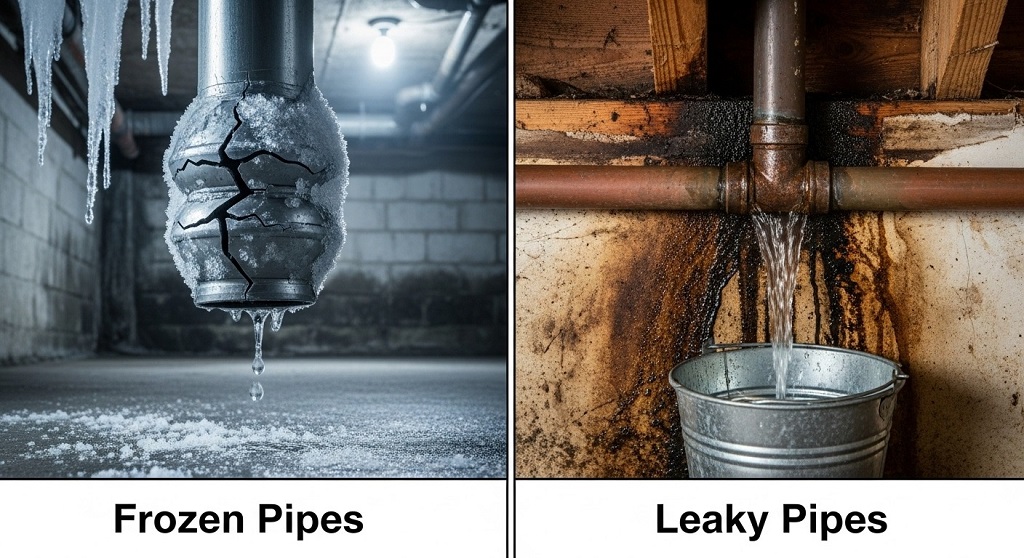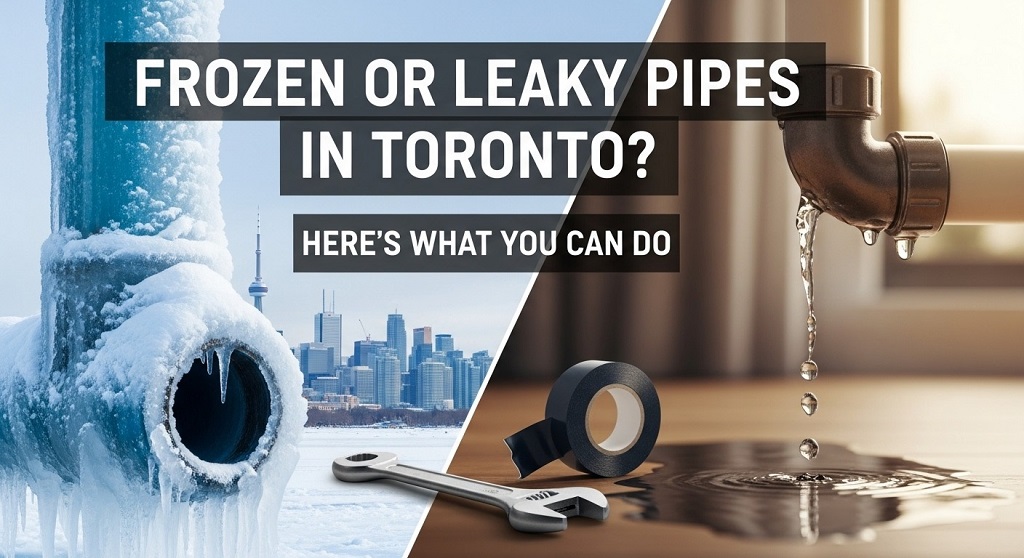Toronto winters deliver beauty and brutal cold. Temperatures often plunge below -20°C, and sudden thaws follow. Consequently, plumbing systems face extreme stress. Each year, the Insurance Bureau of Canada reports that water damage from burst or leaking pipes costs homeowners over $2 billion nationwide. Moreover, the City of Toronto receives thousands of service calls annually for frozen water lines during cold snaps. Homeowners therefore need reliable, immediate actions to protect their properties.
Why Toronto Homes Face Frozen and Leaky Pipes More Often
Cold air finds every gap. Older Toronto neighbourhoods—such as Cabbagetown, The Annex, and Rosedale—contain homes built before 1960. Many still rely on galvanized steel or early copper piping. Insulation standards from that era fall far short of today’s requirements.
Additionally, rapid temperature swings create the perfect storm. Pipes freeze when the mercury drops quickly overnight. Then, when the sun rises and warmth returns, ice expands and ruptures the pipe. Leaks appear in walls, ceilings, and basements before anyone notices the problem.

Signs Your Pipes Have Frozen or Started Leaking
Early detection saves thousands in repairs. Homeowners should watch for these clear warning signals:
- No water comes from faucets or flow is just a trickle
- Frost covers exposed pipes in the basement, garage, or crawl space
- Strange bulging or cracking appears on pipe surfaces
- Unusual banging or clanking noises echo when you turn on taps
- Water stains bloom on ceilings, walls, or baseboards
- Musty odours or visible mould develop in hidden areas
- Your water bill suddenly spikes without explanation
If you spot any of these signs, act immediately.
Immediate Steps When You Discover Frozen Pipes
Stay calm and follow this proven sequence:
- Turn off the main water shut-off valve right away. This prevents flooding once ice melts.
- Open the affected faucet (both hot and cold) to allow melting ice and steam to escape.
- Locate the frozen section. Homeowners usually find it along exterior walls, in unheated basements, or near drafty windows.
- Apply gentle heat using one of these safe methods:
- A hair dryer on medium setting (keep it moving constantly)
- Heating pads or towels soaked in hot water
- Space heaters placed a safe distance away (never leave unattended)
- Heat lamps designed for construction use
Never use open flames or blowtorches. These methods cause pipes to burst explosively.
Continue applying heat until full water pressure returns. Then let the faucet run for several minutes to clear remaining ice.
How to Handle an Active Pipe Leak in Toronto
Water spraying or dripping demands swift response:
- Shut off the main water valve immediately. Every adult in the household must know its location.
- Place buckets or towels to catch dripping water and reduce floor damage.
- Relieve pressure by opening all cold taps in the house, then flush toilets once.
- Turn off the water heater (electric: breaker; gas: pilot dial) to prevent dry firing.
- Call a licensed Toronto plumber who offers 24/7 emergency service.
While you wait, document the damage with photos for insurance claims.
DIY Temporary Fixes for Small Leaks (Until the Plumber Arrives)
Licensed professionals should perform permanent repairs. However, these measures buy valuable time:
- Wrap the leak tightly with rubber patches and hose clamps
- Apply epoxy putty designed for wet conditions (follow instructions exactly)
- Use pipe repair tape layer by layer until the flow stops
- Slip a C-clamp and rubber pad over the rupture for quick pressure
Remember—these solutions remain temporary only. Schedule proper replacement as soon as possible.
Long-Term Prevention Strategies That Actually Work in Toronto
Prevention beats emergency calls every time. Homeowners protect their plumbing with these practical upgrades:
Insulate Exposed Pipes Properly Use foam pipe sleeves, heat tape, or fibreglass wrap on every line in unheated areas. Pay special attention to pipes along north-facing walls and in crawl spaces.
Keep Indoor Temperature Consistent Set your thermostat no lower than 15°C, even when away. Open cabinet doors under sinks on exterior walls to allow warm air circulation.
Install Smart Water Monitors Devices like Flo by Moen or Phyn Plus detect tiny leaks and shut off water automatically. Many Toronto insurers now offer discounts for these systems.
Upgrade Old Piping Gradually Replace galvanized steel with modern PEX or copper during renovations. PEX resists freezing far better and installs quickly.
Let Faucets Drip During Extreme Cold A slow trickle keeps water moving and dramatically reduces freeze risk. Toronto Water recommends this practice when temperatures fall below -15°C.
Seal Drafts and Improve Insulation Caulk gaps around windows, doors, and foundation walls. Add blown-in insulation to attics and basement rim joists.
Special Considerations for Toronto Condo and Apartment Dwellers
Condo owners face unique challenges. Pipes often run through shared walls and concrete slabs. If your unit shows signs of trouble, notify your property manager immediately. The corporation’s master policy usually covers repairs inside walls, while your personal policy covers interior damage.
Act fast regardless—water travels downward and affects neighbours below.
When to Call a Licensed Toronto Plumber Immediately
Some situations require professional help without delay:
- You cannot locate or access the frozen section
- Water continues flowing after you shut the main valve
- Visible corrosion or multiple leaks appear
- Sewage backs up into drains or fixtures
- You suspect the main line to the city has frozen
Toronto plumbers carry specialized equipment like pipe cameras, electric thawing machines, and hydro-jetting tools that resolve issues safely.
Related Topics: Creative Garage Door Designs for Modern Homes
Conclusion
Frozen or leaky pipes in Toronto create stress, but preparation removes most of the panic. Homeowners who insulate properly, maintain steady heat, and know their shut-off valve location rarely face major disasters. When problems do occur, quick action limits damage dramatically.
Take ten minutes today to locate your main shut-off valve and check exposed pipes. Your future self—and your bank account—will thank you when the next polar vortex arrives.
Ready to protect your home this winter? Contact a licensed Toronto plumbing professional for a complete winterization inspection before the deep freeze sets in.
Related Topics: Five Ways to Refresh a Tired Kitchen
FAQs
What temperature do pipes freeze in Toronto homes?
Pipes begin freezing around -6°C inside the home if water remains still for six hours or more. However, wind chill and poor insulation lower that threshold significantly.
Can I use salt or chemicals to thaw frozen pipes?
Never pour salt, antifreeze, or chemical de-icers into plumbing lines. These substances damage pipes and contaminate drinking water.
How long does it take to thaw a frozen pipe safely?
Most residential frozen sections thaw in 30–60 minutes with proper heat application. Thicker ice blockages in main lines may require several hours or professional equipment.
Will homeowners insurance cover burst pipe damage in Toronto?
Most policies cover sudden and accidental bursts. However, damage from neglect (lack of heat or insulation) often faces denial. Review your policy annually.
Are PEX pipes really better for Toronto winters?
Yes. PEX expands up to three times its diameter under freezing pressure and returns to shape when thawed, making bursts extremely rare.
References
- Insurance Bureau of Canada – Escaping Water Damage Reports: http://www.ibc.ca/on/disaster/water
- City of Toronto – Winter Water Service Protection Tips: https://www.toronto.ca/services-payments/water-environment/water-sewer-service-problems/frozen-water-service/
- Canada Mortgage and Housing Corporation (CMHC) – Preventing Frozen Pipes Guide: https://www.cmhc-schl.gc.ca/en/professionals/project-funding-and-mortgage-financing/funding-programs/all-funding-programs/heating-cooling-upgrades









